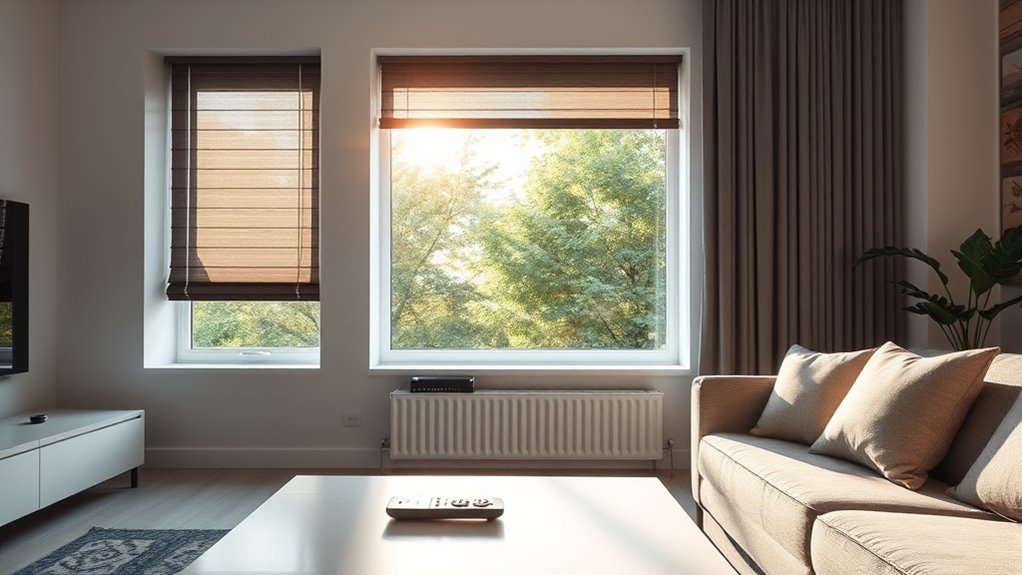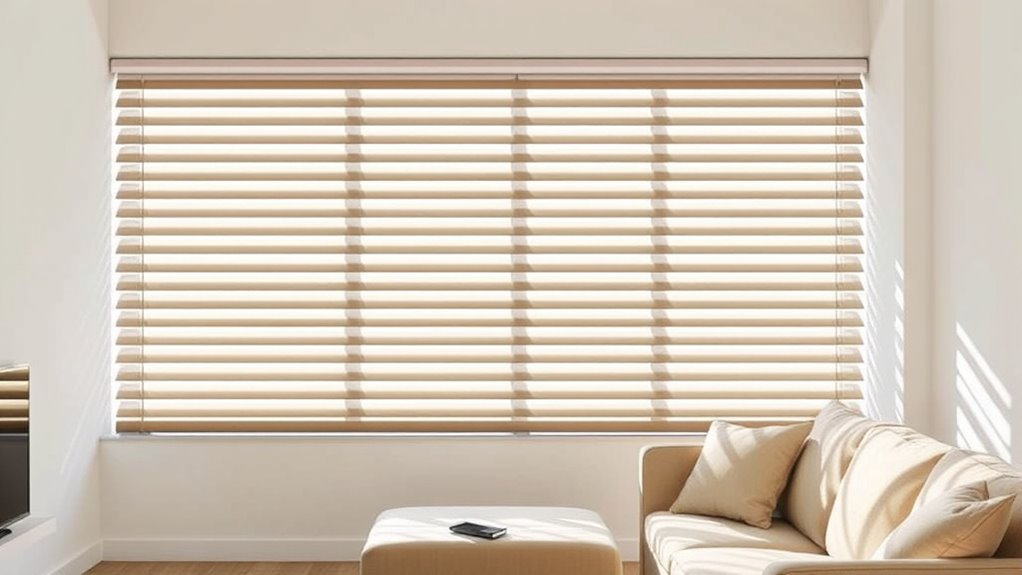With DIY smart blinds, you can easily automate your curtains for lazy mornings by installing motorized tracks connected to a microcontroller and smart home systems. This setup lets you open or close your curtains remotely, schedule them to match your routine, or respond to sunlight and temperature. Not only does this save you time, but it also boosts energy efficiency and comfort. Keep exploring to discover simple steps to build your own automated window coverings.
Key Takeaways
- Build DIY smart blinds with motorized tracks and microcontrollers for automated opening during lazy mornings.
- Connect your system to Wi-Fi for remote control via smartphone or voice assistants like Alexa or Google Home.
- Program automation routines based on time, sunlight, or temperature to wake up naturally.
- Use sensors to automatically open or close blinds, enhancing comfort and energy efficiency.
- Customize your setup for seamless integration into your smart home ecosystem, simplifying morning routines.

Creating your own smart blinds is a rewarding way to enhance your home’s automation without breaking the bank. With a few simple components, you can transform ordinary curtains into intelligent window coverings that respond to your schedule or preferences. One of the key benefits of DIY smart blinds is the convenience of remote control, allowing you to open or close your blinds from anywhere using your smartphone or a dedicated remote. This setup means you don’t have to get up or reach for a switch, especially on lazy mornings or when you’re busy with other tasks. Plus, remote control adds a layer of flexibility—whether you want to automate your blinds based on time, sunlight, or room temperature, you can easily adjust them on the fly.
But beyond convenience, smart blinds considerably contribute to your home’s energy efficiency. When you automate your curtains to open during the day, sunlight naturally warms your space, reducing the need for artificial heating and lowering energy bills. Conversely, closing blinds during the hottest parts of the afternoon keeps your home cooler, decreasing reliance on air conditioning. This dynamic control helps maintain a comfortable environment while saving energy. By integrating sensors or scheduling features, your DIY smart blinds can respond to external conditions automatically, optimizing your energy use without any manual effort. You’ll notice a difference in your monthly electricity bills and feel good about reducing your carbon footprint.
Getting started is straightforward. You’ll need a motorized curtain track or a DIY motor setup, a microcontroller like an Arduino or Raspberry Pi, and a power source. Pair these with a remote control system, such as RF modules or Wi-Fi-enabled controllers, so you can operate your blinds remotely. Programming your setup involves simple coding—many tutorials are available online—that enable your blinds to respond to commands from your smartphone or remote. Once assembled, you can connect your system to your Wi-Fi network, allowing voice commands or automation routines through smart home platforms like Alexa or Google Home. The process is not only fun but also incredibly satisfying, giving you full control over your window coverings. Additionally, incorporating color accuracy concepts can help you optimize the visual appearance of your smart home environment, creating a more comfortable living space.
Getting started is easy with a motor, microcontroller, and Wi-Fi for remote, voice, and automation control.
In the end, creating DIY smart blinds with remote control capabilities offers a perfect blend of practicality and innovation. They make your mornings easier, your home more energy-efficient, and your tech skills sharper—all without overspending. With a little effort, you turn ordinary curtains into intelligent, automated features that make your everyday life more comfortable and eco-friendly.
Frequently Asked Questions
Can I Retrofit Existing Blinds With Smart Technology?
You can definitely retrofit your existing blinds with smart technology using blind motorization and retrofit solutions. These kits are designed to easily attach to your current blinds, allowing you to control them remotely or set schedules. You don’t need to replace your entire setup; instead, you upgrade with minimal effort. Just choose the right retrofit solution for your blinds, and you’ll enjoy the convenience of smart automation without the hassle of new installations.
What Safety Precautions Are Needed During Installation?
During installation, you should prioritize electric safety by turning off power before wiring and avoiding water contact. Follow DIY precautions by reading instructions carefully, using proper tools, and wearing safety gear. Confirm all connections are secure and insulated to prevent shorts or shocks. If you’re unsure about handling electrical components, consider consulting a professional. These steps help you install your smart blinds safely and avoid accidents.
How Do Smart Blinds Impact Energy Efficiency?
Smart blinds boost your home’s energy efficiency by improving insulation benefits and reducing energy savings costs. When you install them, you can automatically adjust your blinds based on sunlight, helping keep your space cooler in summer and warmer in winter. This control minimizes heat transfer through windows, lowering your reliance on HVAC systems. As a result, smart blinds help you save energy and create a more comfortable, eco-friendly living environment.
Are There Options for Voice Control Compatibility?
Like a conductor guiding an orchestra, you can control your smart blinds effortlessly with voice control options. Many smart blinds are compatible with popular voice assistants like Alexa, Google Assistant, or Siri, allowing you to open or close them with a simple command. They also support app integration, giving you flexible control from your smartphone or tablet. This seamless compatibility makes your mornings smoother and your home more intuitive.
What Is the Average Lifespan of DIY Smart Blinds?
You might wonder about the average lifespan of DIY smart blinds. While durability concerns vary based on materials and build quality, most DIY options last around 3 to 7 years with proper maintenance. Regularly checking the motor and cleaning the components can prolong their lifespan. Keep in mind, lower-quality parts may require more frequent repairs or replacements, so choosing durable materials and following maintenance requirements helps ensure longevity.
Conclusion
By creating your own smart blinds, you can enjoy a more convenient, energy-efficient home. Did you know that automated window coverings can reduce energy costs by up to 25%? With just a few DIY steps, you can wake up to natural light and save money on heating and cooling. It’s a simple project that makes your mornings easier and your home smarter—so why not give it a try and transform your space today?









